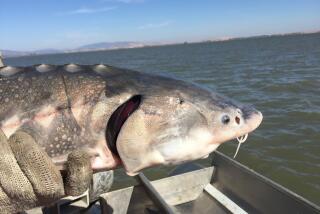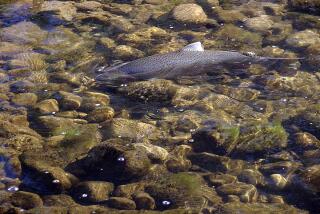THE OUTDOORS : STURGEON GENERAL : Anglers Operating in Bay Area Waters Search for the Monster Fish That Time Forgot
- Share via
CROCKETT, Calif. — Capt. Mike Andrews guided his boat slowly through the morning haze to an area just past Benicia. This, he said, seemed the best place to carry on the search for one of nature’s more interesting creatures, the white sturgeon.
The 40-foot sportfisher, one of a small fleet berthed beneath the Carquinez Bridge, was the first out. A chilling breeze nipped at Andrews’ red-faced passengers, all regulars, who hoped this would be their lucky day.
The smell of rain was in the air and an approaching storm’s clouds were already competing with the rising sun. But that didn’t matter. Sturgeon fishermen, Andrews says, are a breed apart from fair-weather anglers.
“These same guys were out last week and it was so cold I had to wipe the ice off the inside of the windshield before we could even leave the dock,” he said. “We were out one day and got hit by lightning. Everything went dark on the boat . . . and it’s true what they say about lightning having a weird smell.”
Rain or shine, Andrews, 34, who has fished these Bay Area waters and elsewhere for most of his life, says sturgeon fishermen are always willing to pay $35 for a chance to tangle with their favorite foe.
What is it about this living relic of a fish that commands such dedication? After all, it sucks mud to get food and is arguably the ugliest creature to inhabit these waters.
For starters, it is the largest freshwater fish in North American waters. It can reach nearly a ton--some say more--and lives for more than 100 years.
Toothless, it has an unsightly sucker of a mouth that extends and probes for food through the mud and sand. It plows through San Francisco Bay and through the delta region, through the Sacramento and San Joaquin rivers and anywhere else it cares to go. The species thrives on the West Coast from Ensenada to the Gulf of Alaska.
Its rubbery whiskers and an acute sense of smell guide it through the water, brackish or fresh, and an armor-plated back provides protection. Fish and Game officials say it looks much the same today as it did when it swam the primeval oceans and estuaries 200 million years ago.
The possibility of such a catch is enough to warrant a trip under any conditions, Andrews’ passengers agreed.
Vern Haskin, a Santa Rosa angler who has fished for sturgeon for the last 2 1/2 years, said he has yet to catch a keeper, which must be at least 40 inches long. “And I come out at least once a week,” he added.
Kent Phillips, also of Santa Rosa, caught his first keeper recently.
“Yeah, it was 40 3/4 inches,” Haskin interrupted, indicating that Phillips’ first keeper was just legal.
Scott Seymour’s best in two years of fishing regularly for sturgeon has been a 36 1/2-inch fish, but Andy Maez of Concord has done significantly better--as the picture in his wallet attests. It shows the 245-pound sturgeon he caught off nearby Roe Island in 1978.
“It jumped 20 times and took four hours to catch,” he boasted. “I’ve caught several.”
And others have fared even better.
Fishing in 1983 off a point just south of the Benicia Bridge, Joey Pallotta caught a world-record 468-pound sturgeon that measured nine feet and was estimated to be 100 years old. Pallotta said he battled the monster for four hours.
“The fish surfaced immediately and when I first saw it, I went into shock,” he said. “Even if I could fight it, I didn’t think there was any way we could get it in the boat.”
Rather than attempt that, Pallotta, in an 18-foot runabout, radioed for help. Tom Glakeler, in a 26-foot cruiser, responded and Pallotta, pole in hand, hopped aboard.
Said Glakeler: “The fish pulled us all over the place. The third time it came up, it danced on its tail across the water, like a marlin.”
In 1981, when Bill Stratton caught a 12-foot-2, 390-pound sturgeon not far from Benicia, he thought at first that the bite might have been a small catfish.
Stratton said at the time that after the initial “bump,” he set the hook and the fish immediately began to pull the houseboat he was fishing from.
“Then I knew whatever it was, it wasn’t little,” he said.
The sturgeon, Stratton’s first keeper in 3 1/2 years of fishing for them, was a world record in the 30-pound-test line category.
“I’d caught six sturgeon before, all undersize, and tossed ‘em all back,” he said. “Like most guys up here who fish for sturgeon, I was hoping to catch a monster. Well, I did.”
In Stafford Lake near Novato, Calif., fishermen for years told of a creature that dragged poles into the water and then vanished.
The lake was eventually drained by the Marin County Water District so a dam could be repaired and the mystery was solved. A 6-foot-5 sturgeon lay flopping in the puddle that remained, a fish that officials said was between 50 and 60 years old.
One sturgeon caught in the Soviet Union was reported to have been 26 feet long and weighing 3,200 pounds. The largest recorded in California--one caught in a net--was a 12-footer that weighed 1,285 pounds.
Such fish aren’t common, but enough sizable fish show up in the fish counts to maintain a following among Andrews’ customers, who in recent weeks caught fish ranging from the undersized shakers-- those that you shake off the hook--to the 227-pounder caught during the recent blast of Arctic air that iced Andrews’ inner windshield.
“The funny thing about sturgeon is that they’re really big and they’re a real challenge, and that’s what keeps everybody going,” he said. “If you just went by numbers, nobody would ever want to go fishing for them.”
Sturgeon are known not only for their size and mystique, but for their eggs, from which caviar is made. For this reason alone, its history as a fishery has been a precarious one.
Iranians over the years harvested the fish to dangerous levels. The rare golden caviar, from the noble beluga sturgeon--indigenous to the Caspian Sea--was reserved solely for the royal court of the Shah of Iran in the early 1970s and was served only on ceremonial occasions or presented to visiting dignitaries.
Iranian caviar production has dropped significantly because of pollution and over-fishing--legally and illegally. Though Iranians themselves generally don’t like caviar--most is exported--sturgeon kebabs are a specialty item in many restaurants.
Fishing for the giant Chinese sturgeon has been banned because dams built on China’s Yangtze River have threatened its survival. Everything from fish ladders to cutting the fish open, taking the eggs, sewing it back up, and releasing it alive, has been tried. But the decline continues.
Fishing for sturgeon in the San Francisco Bay area had to be halted in 1917 because of heavy commercial fishing pressure. Gill netters fishing for salmon in the Sacramento and San Joaquin rivers caught sturgeon by the thousands, and many considered them pests because their armor-plated backs destroyed the nets.
Sportfishing resumed again in 1954 with a 40-inch, one-fish limit that is still enforced. Stiff penalties await those who attempt to market their fish commercially.
Efforts are under way at UC Davis to repopulate the species through artificial propagation and several thousand have been released.
Based on legal-sized fish that were tagged and recovered by the Department of Fish and Game, population estimates have fluctuated from 11,000 in 1954 to 139,000 in 1984, to 84,000 in 1987.
There have been transplants to inland reservoirs, with varying degrees of success. Lake Havasu, for instance, was planted in the late 1960s and there have been no signs of the fish since. On the other hand, just three years ago, Irvine Lake received hundreds of small sturgeon, which it bills as “the fish that time forgot,” and several in the 10-pound range have been caught.
Spawning doesn’t occur until the fish reach about 15 years. Females spawn--in this area, usually above the San Joaquin-Stanislaus River junction--from February to May.
Fertilized eggs sink to the bottom and adhere to the rocky substructure, then hatch in two to 10 days. Seven to 10 days later the tiny fish begin feeding on small invertebrates. After that, they continue to feed on herring eggs, ghost and grass shrimp.
Andrews’ customers, and most sturgeon fishermen, use as many grass and mud shrimp as they can fit on their hook, along with a sliding sinker and 40-pound test line.
Rocks and twigs have also been found in sturgeons’ stomachs, and a half-bushel of onions was found in one fish caught in Idaho’s Snake River.
Fishing in San Francisco’s central bay is closed from Jan. 15 to March 15, when herring spawning is at its peak.
“The herring come into the bay to spawn and the sturgeon are really attracted to herring eggs,” Andrews said. “They are easily snagged during that time.”
A snagged fish is an illegal fish and must be thrown back.
Though Andrews says this has been a pretty good year, no sturgeon were caught after the first couple of hours on this particular trip.
The threat of rain had subsided and the inactive but impressive Glomar Explorer was moored in the distance. A fleet of moth-balled cargo carriers, linked together in rows in Suisun Bay, offered an awesome display of steel.
But there were no sturgeon. Just plenty of sturgeon stories.
“Once they get on the line they make real long runs,” Andrews said. “We fought a 7-footer this month for an hour and 20 minutes, and we had a 95-pounder that took 1:45, so there are some long fights.”
Phillips, still hoping to catch a keeper, told of one that got away after he had hooked it in five feet of water.
“It spooled about three quarters of my line so the skipper said, ‘We’re going to have to tie a bucket on the line and throw the rod over.’ I said, ‘What? . . . are you serious?’ ”
The skipper was. He tossed Phillips’ rod into the water and gave chase, the bucket surfacing now and then until the boat caught up two miles away.
“I reeled in half my line and there it was,” Phillips said. “The fish was eight feet long and came completely out of the water right in front of the boat.”
But it had shaken the hook and immediately disappeared.
“Last year, a gentleman hooked a 90-pounder and it looked like I was going to have to pull the anchor up (to give chase),” Andrews said. “Then the guy on the back of the boat hooked a fish similar size and his fish is going the other way.”
Andrews tied a float to one and tossed it overboard, chased down the other one and landed it after a 40-minute fight. He then went back and located the float, which was attached to another 90-pound sturgeon.
“We got both fish,” he said.
Suddenly, attention shifted to the boat’s stern. The tip of Seymour’s rod was dipping ever so slightly. He picked it up and gave a quick jerk to set the hook. Several minutes later he pulled over the rail the first sturgeon, just shy of 40 inches. Seymour kissed the sturgeon’s tube-like mouth with both lips, smiled, and tossed it back into the water.
“It’s a superstitious thing among some of these guys,” Andrews said, explaining that if you kiss the undersized fish before throwing them back, they will grow into monster fish.
One more shaker, a kiss goodby, and the boat headed back to Crockett Sportfishing to prepare for the next day’s outing, and more hopeful sturgeon fishermen.


